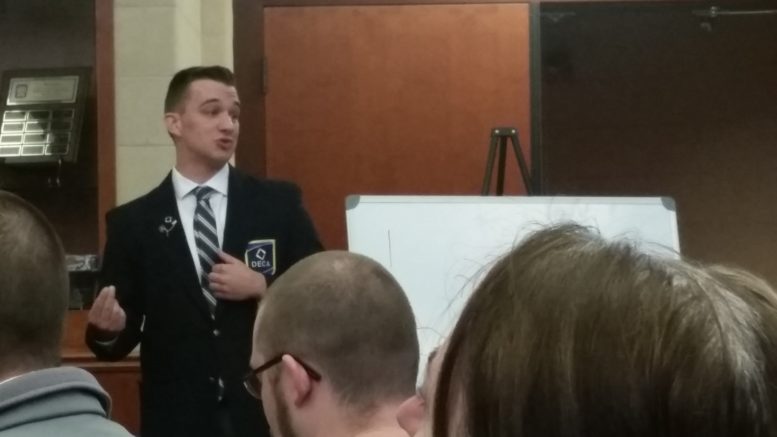By JAN LARSON McLAUGHLIN
BG Independent News
Alzheimer’s Disease is like a melon baller, scooping out holes in memory banks of brains.
After watching Alzheimer’s take away so much from his grandfather, Jacob Kielmeyer is working on a way to help people suffering with the disease.
Kielmeyer, a senior at Bowling Green High School and the son of David and Diane Kielmeyer, presented his “Nostalgia” app that he created for his DECA class to the board of education Tuesday. The project earned Kielmeyer first place at the DECA district level and qualified him for state competition.
And best of all, it could actually become a tool that families can use to help their member with Alzheimer’s regain enjoyment from their memories.
The “Nostalgia” program offers a new approach to memory therapy by creating a first-person interactive world designed by family members. The program pairs familiar sounds with familiar photographs to help Alzheimer’s patients get past those holes in their memories.
The student was inspired to create the program by his grandpa, Donald Kielmeyer, who died in 2008 after suffering many years with Alzheimer’s. The app he showed Tuesday was designed with his grandpa in mind. The computer screen flashed images of his grandpa’s favorite places – the Main Street of his town, the church he attended for years, a favorite restaurant, a treasured fishing spot, and the Ohio State University football stadium – which his grandpa frequented to cheer on the Buckeyes.
The program, created by family members who know the patient best, can then be controlled by the person with Alzheimer’s, allowing them through touch to decide whether they want to go to church, fishing, or out for a favorite meal.
Meanwhile, the music (also selected by family members) plays favorite songs personalized for the patient. The app designed for Kielmeyer’s grandpa even replayed a portion of an OSU game pitting Woody Hayes against University of Michigan’s Bo Schembechler.
“It allows the family to make it familiar,” Kielmeyer said. “That’s the power of ‘Nostalgia.’”
Kielmeyer was asked by the school board if he had considered taking his idea to the “Shark Tank” TV show for inventors.
“I have thought about doing something like that,” he said. But Kielmeyer said he was instead working with Dr. Laura Landry Meyer, at BGSU, to possibly get a grant from the Alzheimer’s Association.
“I think his idea has a lot of merit,” Meyer said when contacted about the project.
Meyer explained that Alzheimer’s destroys the neurons that allow connections in the brain. She described it as the melon baller scooping out links in the brain.
“There are actually holes there,” she said. “If I hit that huge pothole, I don’t know how to go around it.”
But by using music and images of familiar faces and places, some neurons in the brain can actually be triggered.
“It’s multi-sensory, so they are able to go around the holes,” she said. Even if they are unable to make the exact connections, the music and images from years gone by can be of comfort to Alzheimer’s patients.
Meyer said Kielmeyer presented his “Nostalgia” project to her students at BGSU. “I’m so impressed with him,” she said.

